Hohenlinden 1800:
The Forgotten Battle
The Battle of Hohenlinden
by Guenter Schneider, Germany
| |
Jumbo Maps: monstrously slow: 1.2Mb In the centre of the battlefield from Preisendorf over Kronacker and Hohenlinden up to the settlements of Birkach and Kreith the struggle of the divisions Ney and Grouchy could be experienced - both tragic figures of the 1815 campaign - against the troops of the Austrian General Baillet-Latour and the advance-guard under General Löppert.
Finally there was the most dramatic part of the battle which took place near Maitenbeth and in the thick forest around this village. Richepance crossed the wood only with the 8th and 48th half-brigades of the line and the 1st regiment of chasseurs à cheval to attack the back of the Austrian column of Feldzeugmeister Kolowrat. Moreau planned to resist the Austrian attacks in the plain of Hohenlinden and to out flank them by 10,000 men under Richepance who should fall them in the back at Maitenbeth . Decaen with another 10,000 men had to support this movement. The Austrians did not think to give battle to the French on this day. They only wanted to advance quickly to reach Anzing and Munich, the Bavarian capital on the following day. The French had about 55,000 men with nearly 100 guns, whereas the Austrians with the allied Bavarians had about 60,000 men and more than 100 guns. The weather on the morning of 3 Decembre did not favour neither the Austrians nor the French. Big snow flakes were falling and the soldiers could not see ten paces in front of them. Very early in the morning the advance-guard of Löppert had attacked Grouchy in front of Hohenlinden. Moreau arrived at this section of the battlefield at seven o´clock and conducted the defence of the road to Munich. Grouchy supported by Ney could resist the Austrian attacks. Löppert was supported by more and more batallions of Kolowrat´s column, but the French could advance slowly in the direction of the entrance of the Ebersberger forest. When the attack of Richepance was noticeable, Ney even entered the forest fol lowed by Grouchy´s men.
Jumbo Maps: monstrously slow: 1.2Mb But Grenier held his position against Kienmayer although the Austrians had always a numerical superiority. Kienmayer was supported by parts of the column of Baillet-Latour, and Legrand and Bastoul were reinforced by the reserve brigade of Ney and the cavalry of d´Hautpoul. Even the battlefield was advantageous to the Austrians, for they could fight from a height which dominated the road from Hohenlinden to Erdingen, the position of Grenier. But Kienmayer´s column was only halfheartedly supported by Baillet-Latour who kept staying on the steep hill near Mittbach, being too fearful to go down the hill to attack Hohenlinden or Kronacker with his forces. The French attacked the Austrians on this part of the battlefield as well and threw them back when those felt the advance of Richepance near Maitenbeth. During the final attack General Bastoul was mortally wounded and he finally died in January 18 01 in Munich as a result of his wounds. His tomb on the old south cemetery in Munich is the only tomb which remembers of the battle of Hohenlinden.
Richepance, who knew that Drouet would be supported by Decaen, left the struggle behind him in order to march towards Maitenbeth and to carry out his order. It became a very hard march through the forest. Most of the time the cavalry could only move forward one by one, and all had to fight with the snow, the cold, the ice and the marsh. In addition to all this the native leader got lost and had difficulties to find the right way. In the face of all these adversities Richepance reached Maitenbeth, attacked the reserve cavalry under Prince Liechtenstein, let the 8th half-brigade and the 1st chasseurs to keep them in check and stormed forward to the entrance of the forest only accompanied by the 48th half-brigade. When Decaen reached St. Christoph at 10:30 a.m. he immediately sent general Kniaziewicz to support Drouet in order to be able to follow his division. Finally Drouet succeeded and broke through so that he could continue his march behind Richepance towards Maitenbeth. In his report Decaen wrote very poeticly: This spectacle was even more fascinating because at the moment of success the snow stopped falling and the sun began shining with all his brightness. In the meanwhile Richepance had entered the Ebersberger forest from the east. With the 48th he advanced very quickly on the road to Hohenlinden and he cleared a path through everything that wanted to block his way. The French attacked the Austrians from behind, each bataillon which tried to hold their advance was crushed and dispersed into the wood. Soon Richepance met the first troops of general Ney who advanced from Hohenlinden, and at this moment Richepance could return to Maitenbeth to support the brigade Walther.
On the road there was nothing more than dispersed carcasses, frightened horses without men, overturned carri ages and caissons and 87 guns in our hands. It was 6:00 p.m. and the night saved the Austrian army from total destruction. At 4:00 p.m. the battle was won with such a great superiority that on a summerday we would have had still 5 hours to fight. Then the Austrians would not have been able to carry away 70 guns and more than half of their army would have been destroyed. The French lost about 1,200 dead and wounded whereas the Austrians lost nearly 1,000 dead, more th an 3,600 wounded and over 7,000 prisoners. The Austrians had no real chance to win the battle, because too many mistakes were made. Lieutenant General von Zweibrücken the commander of the Bavarians mentioned th em in a letter to the Elector of Bavaria Maximilian IV. Joseph: The Austrians thought that the French were on the retreat, they did not suppose to give battle on this day. The march of the columns was not arranged, so that Kolowrat on the wide road was much earlier in the forest than the others. For their advance Kienmayer, Baillet-Latour and Riesch had to take extreme bad ways. Riesch even had a much longer advance than the other columns. In addition there was no connection between the columns, no patrols were sent out to reconnoitre in the forest. The most awful accusation of Zweibrücken is the statement that at 5:30 a.m. the whole command of the Austrians was still asleep, John as well as Lauer or Weyrother, although their troops were on the march to Hohenlinden. The decisive mistake was that the Austrians did not believe in giving battle thi s day. They could not imagine that th e French stood at Hohenlinden to wait for thei r arrival and even to turn them through the th ick Ebersberger Forst. Under these conditions a victory of the Austrians at this special day was very improbable. Hohenlinden 1800 The Forgotten Battle
The Campaign in South Germany The Commanders of the French and Austrian Armies The Hostilities Re-Open Battle of Hohenlinden The Aftermath French Army of the Rhine Austro-Bavarian Army Back to Table of Contents -- First Empire #64 Back to First Empire List of Issues Back to MagWeb Master Magazine List © Copyright 2002 by First Empire. This article appears in MagWeb (Magazine Web) on the Internet World Wide Web. Other military history articles and gaming articles are available at http://www.magweb.com |

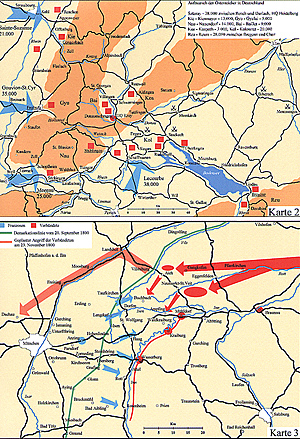 The battlefield may be divided into
four sections: In the north of Hohenlinden
the French divisions Legrand and Bastoul
(who replaced the wounded General Hardy)
stood between Harthofen and Forstern. They
had to resist the attacks of the Austrian
corps Kienmayer which advanced between
Buch and Wetting.
The battlefield may be divided into
four sections: In the north of Hohenlinden
the French divisions Legrand and Bastoul
(who replaced the wounded General Hardy)
stood between Harthofen and Forstern. They
had to resist the attacks of the Austrian
corps Kienmayer which advanced between
Buch and Wetting.
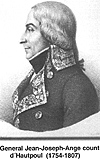 In the north of the village of Hohenlinden
d´Hautpoul (left) held position with his reserve cavalry.
The third section of the battlefield was
the area around the villages of St. Christoph
and Schützen, where Decaen supported the
brig ades Drouet and Sahuc of the division
Richepance against the Austrians under Riesch.
In the north of the village of Hohenlinden
d´Hautpoul (left) held position with his reserve cavalry.
The third section of the battlefield was
the area around the villages of St. Christoph
and Schützen, where Decaen supported the
brig ades Drouet and Sahuc of the division
Richepance against the Austrians under Riesch.
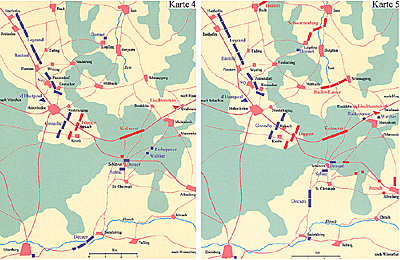 On the north flank of the battlefield Grenier´s divisions
had to resist the attacks of Kienmayer who arrived on the
heig hts between Buch and Wetting after 10:00 a.m. to turn
the French left flank and to at tack Hohenlin den from the north.
On the north flank of the battlefield Grenier´s divisions
had to resist the attacks of Kienmayer who arrived on the
heig hts between Buch and Wetting after 10:00 a.m. to turn
the French left flank and to at tack Hohenlin den from the north.
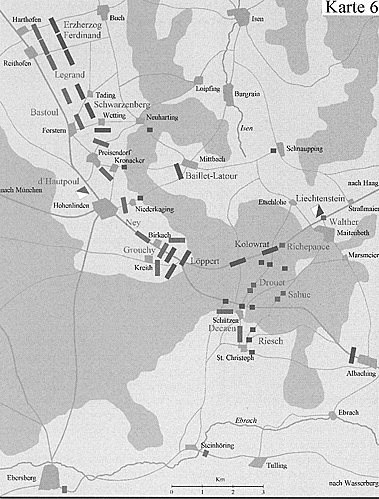 All these actions were influenced by the attack of
Richepance near Maitenbeth. Richepance had already arrived at
St. Christoph very early in the morning. At this place he
gathered his troops and shortly after 7:00 a.m. he started to
advance through the forest to Maitenbeth. But when the half of
his division had passed the road from Hohenlinden to Albaching
and Wasserburg Austrian troops attacked him and blocked the
advance march of the rest of the division under Drouet.
All these actions were influenced by the attack of
Richepance near Maitenbeth. Richepance had already arrived at
St. Christoph very early in the morning. At this place he
gathered his troops and shortly after 7:00 a.m. he started to
advance through the forest to Maitenbeth. But when the half of
his division had passed the road from Hohenlinden to Albaching
and Wasserburg Austrian troops attacked him and blocked the
advance march of the rest of the division under Drouet.
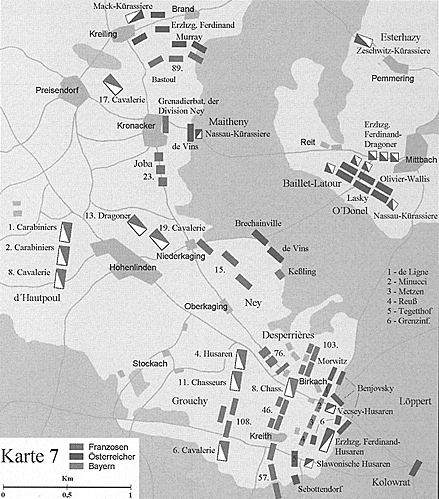 The chief of staff of the Army of the
Rhine General Dessolle reported about this
attack: Horrible cries were to be heard.
Death followed the refugees through the
forest behind the firs where they tried to find protection.
The chief of staff of the Army of the
Rhine General Dessolle reported about this
attack: Horrible cries were to be heard.
Death followed the refugees through the
forest behind the firs where they tried to find protection.